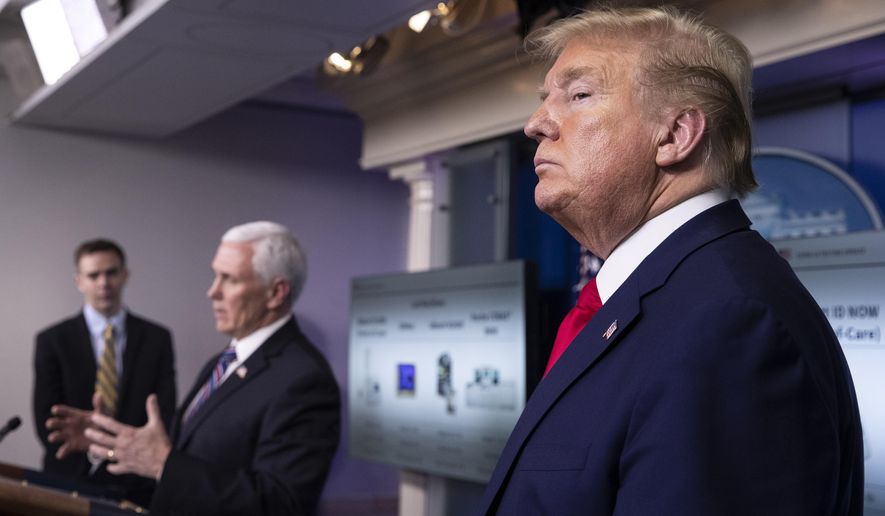President Trump has been mocked relentlessly for suggesting that ultraviolet light could be brought “inside the body” to kill the coronavirus, but there is ongoing research to do just that.
For example, the pharmaceutical firm Aytu BioScience announced on April 20, four days before the Trump remarks, that it has signed an exclusive licensing deal with Cedars-Sinai Medical Center in Los Angeles. The center has developed and is testing a UV-A “Healight” designed to be inserted via a catheter inside the trachea to kill pathogens, including the coronavirus.
Ultraviolet, or UV, light is commonly used by physicians to treat skin diseases. Cedars-Sinai says UV-A phototherapy potentially could be employed in internal organs.
Aytu BioScience said: “The Healight technology employs proprietary methods of administering intermittent ultraviolet (UV) A light via a novel endotracheal medical device. Pre-clinical findings indicate the technology’s significant impact on eradicating a wide range of viruses and bacteria, inclusive of coronavirus. The data have been the basis of discussions with the FDA for a near-term path to enable human use for the potential treatment of coronavirus in intubated patients in the intensive care unit (ICU).”
At Thursday’s White House pandemic task force briefing, Mr. Trump talked of possible future therapies. On the dais, William Bryan, acting director of the Department of Homeland Security’s science and technology sector, briefed reporters on how UV light can kill surface viruses. Mr. Byran also spoke of experiments with bleach and isopropyl alcohol eliminating viruses in expelled saliva and respiratory fluids.
This prompted Mr. Trump to say, “I see the disinfectant where it knocks it out in a minute. One minute. And is there a way we can do something like that by injection inside or, or almost a cleaning?”
And then he turned to ultraviolet light.
“Question that probably some of you are thinking of if you’re totally into that world, which I find to be very interesting,” he said. “So supposing we hit the body with a tremendous, whether it’s ultraviolet or just very powerful light. And I think you said that hasn’t been checked but you’re going to test it. And then I said, supposing you brought the light inside the body, which you can do either through the skin or in some other way. And I think you said you’re gonna test that, too.”
The president was roundly mocked for both suggestions, more so for disinfectant than for UV light.
The Drudge Report said at the top of its home page: “Trump: Inject Disinfectants into Body? Test UV Light Inside Patients.”
Inserting UV light is exactly what Cedars-Sinai is investigating and is talking to the Food and Drug Administration about securing emergency approval for Healight.
The Aytu BioScience’s statement quoted Dr. Mark Pimentel, who is leading the project: “Our team has shown that administering a specific spectrum of UV-A light can eradicate viruses in infected human cells (including coronavirus) and bacteria in the area while preserving healthy cells.”
Dr. Ali Rezaie, one of the Healight inventors, said: “Our lab at Cedars-Sinai has extensively studied the effects of this unique technology on bacteria and viruses. Based on our findings we believe this therapeutic approach has the potential to significantly impact the high morbidity and mortality of coronavirus-infected patients and patients infected with other respiratory pathogens. We are looking forward to partnering with Aytu BioScience to move this technology forward for the benefit of patients all over the world.”
Aytu Bioscience web page states, “The Healight is a catheter embedded with small LED lights that emit UVA light in a specific way.”
The Cedars-Sinai Healight team published an article last year in the United European Gastroenterology Journal, titled “Internally Applied Ultraviolet Light as a Novel Approach for Effective and Safe Anti-Microbial Treatment.”
“These findings suggest that UVA therapy can potentially provide a safe and effective novel approach to antimicrobial treatment via phototherapy on internal organs,” Aytu BioScience says on its website.
Unfiltered UV light is dangerous to humans. But filtering out the harmful UV-C and leaving just UV-A, makes it safe, the company says.
A video animation shows a catheter being inserted inside the trachea, stopping at the bronchial tubes and the light being administered.
Infection is one of the most common and serious side effects for intensive care patients on tracheal intubation to breath.
• Rowan Scarborough can be reached at rscarborough@washingtontimes.com.




Please read our comment policy before commenting.